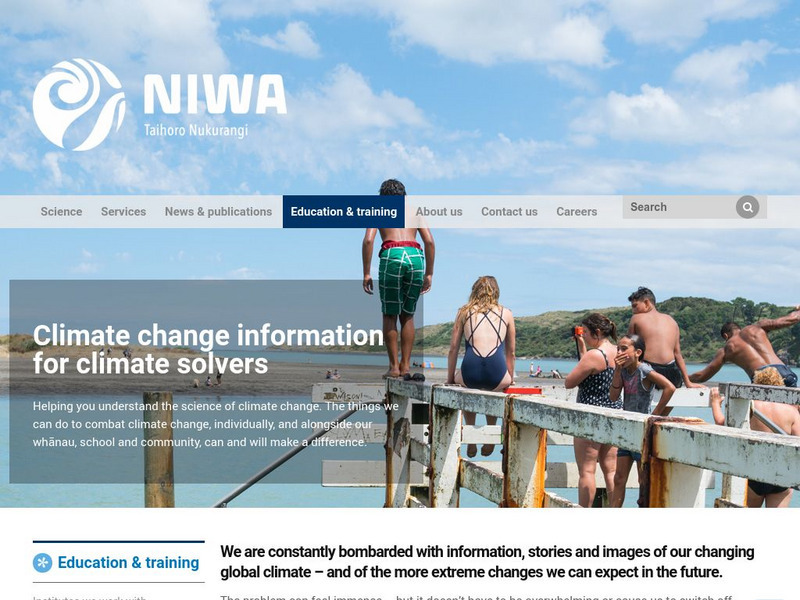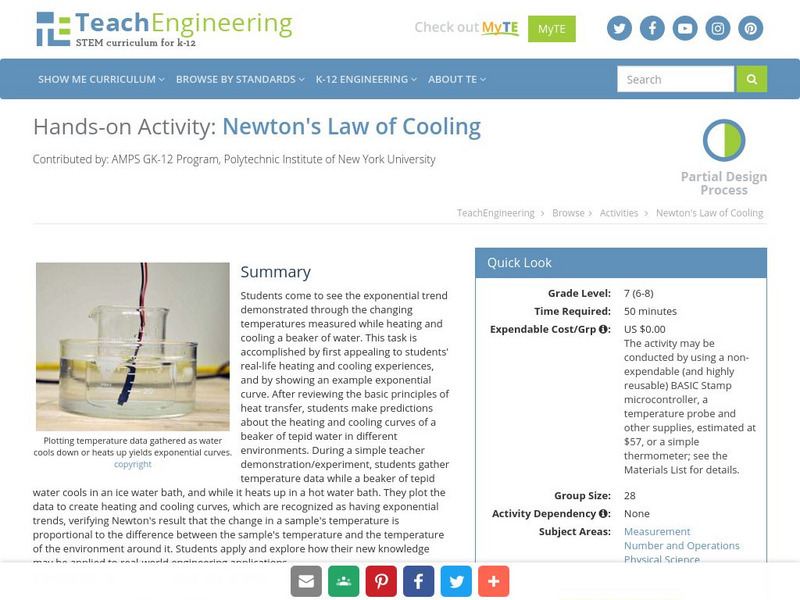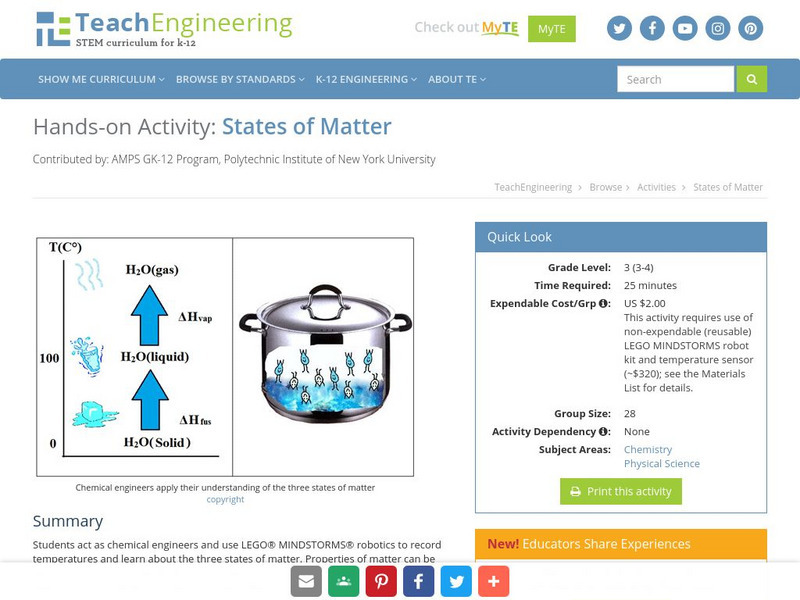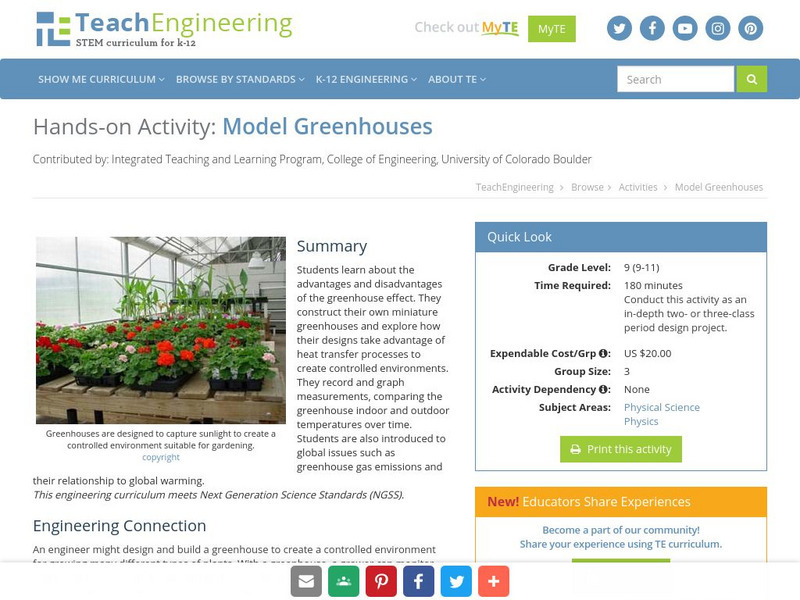Texas Education Agency
Texas Gateway: Temperature
Read and view examples and formulas about temperature, its measurement by thermometers, and its relationship to thermal equilibrium.
Mocomi & Anibrain Digital Technologies
Mocomi: Fun Facts About Temperature
Learn about units of temperature and other interesting facts.
NASA
Nasa: Trends of Snow Cover and Temperature in Alaska
This lesson plan allows students to use NASA satellite data observations with surface measurements of snow in Alaska. Students will be able to make scientific predictions, find data correlations, and learn about data collection methods.
Physics Classroom
The Physics Classroom: Thermal Physics: Measuring the Quantity of Heat
Through interactive exercises and illustrated example problems, students learn about specific heat capacity and measuring the quantity of heat.
E-learning for Kids
E Learning for Kids: Science: Atlantic Ocean: What Is Temperature?
Students learn the difference between heat and temperature, how temperature is measured, and about the Celsius scale.
PBS
Pbs Kids Afterschool Adventure!: Operation: Dog House Design Activity Plan
Children will learn about and explore measurement to successfully design a dog house for his or her cutout paper dog. Each section of this weeklong adventure is introduced by a video clip or online game that encourages children to...
Science4Fun
Science4 Fun: Temperature
Discover interesting facts about temperature and learn the different ways it is measured.
New York University
New York University: Measurement of Energy
Provides information about the distinction between heat and temperature, and allows you to check your understanding through exercises. The Kelvin, Fahrenheit, and Celsius temperatures are compared and discussed.
Other
Online Conversion
Conversion calculators galore! Convert just about anything from one measureable unit into another measureable unit here with over two dozen calculators. Each of the links is specific to a measureable quantity. Some examples include...
Science Struck
Science Struck: Who Invented the Thermometer?
Read about the history of the thermometer and the different types of thermometers and temperature scales that were invented.
Science Struck
Science Struck: Types of Thermometers
Learn about the different types of thermometers, their applications, and how they work.
Creative Science Centre
Creative Science Centre: An Electric Thermometer
Instructions for how to make an electrical thermometer. The electrical thermometer works like this - the design consists of four resistors each made from about 40 meters of very thin copper wire. The electrical resistance of wire changes...
Other
Niwa: Climate Change, Global Warming, and Greenhouse Gases
Want to learn more about climate change, global warming, and greenhouse gases? This web page contains links to websites around the world concerned with providing information about these. Topics include climate shift, greenhouse effect,...
Other
Tech Learning: Students Examine Bio Diversity Nov. 2003
Read about the use of data loggers in one high school class. The data loggers were the key to quantifying the relationship between temperature, light, and biodiversity. Although this is relevant to high school science links are provided...
TeachEngineering
Teach Engineering: Newton's Law of Cooling
Middle schoolers come to see the exponential trend demonstrated through the changing temperatures measured while heating and cooling a beaker of water. This task is accomplished by first appealing to students' real-life heating and...
ClassFlow
Class Flow: Keeping Warm
[Free Registration/Login Required] Through this unit children build their ideas about temperature as a measure of how hot or cold objects are and learn about thermal insulators as materials that can help to keep things warm or cool.
Famous Scientists
Famous Scientists: Anders Celsius
Learn about the life and work of Anders Celsius, the Swedish astronomer who proposed the Celsius temperature scale which bears his name.
Center for Innovation in Engineering and Science Education, Stevens Institute of Technology
Ciese: Wonderful World of Weather Project
If you're studying the weather, this is an excellent project for young scholars to develop their understanding of how weather is measured. They will use real time data from their location as well as from around the world to learn about...
Read Works
Read Works: Tornado Scientists
[Free Registration/Login Required] An informational text about tornadoes and the scientists who study them. A question sheet is available to help students build skills in reading comprehension.
PBS
Pbs Learning Media: Daily and Seasonal Weather: Interactive Lesson
Students investigate the relationship between daily weather and seasonal weather. Students will read about how weather data is collected, then interpret examples of weekly and monthly weather data to find seasonal patterns. Visual...
TeachEngineering
Teach Engineering: States of Matter
Students act as chemical engineers and use LEGO MINDSTORMS NXT robotics to record temperatures and learn about the three states of matter. Properties of matter can be measured in various ways, including volume, mass, density and...
TeachEngineering
Teach Engineering: Model Greenhouses
Students learn about the advantages and disadvantages of the greenhouse effect. They construct their own miniature greenhouses and explore how their designs take advantage of heat transfer processes to create controlled environments....
Other
Colorado Geological Survey: Gradient Map
This site provides geothermal maps of Colorado with the intent being to identify possible sources of geothermal energy. It explains how the temperature measurements were taken and the reasons the results must be considered to be...
Khan Academy
Khan Academy: Transforming Data Problem
It is very common to take data and apply the same transformation to every data point in the set. For example, we may take a set of temperatures taken in degrees fahrenheit and convert them all to degrees celsius. How would this...

















